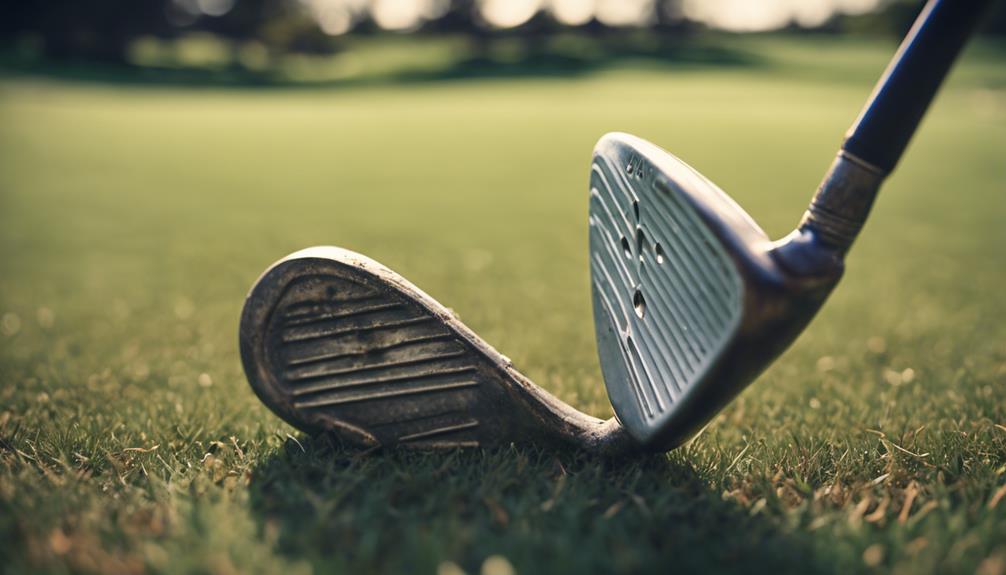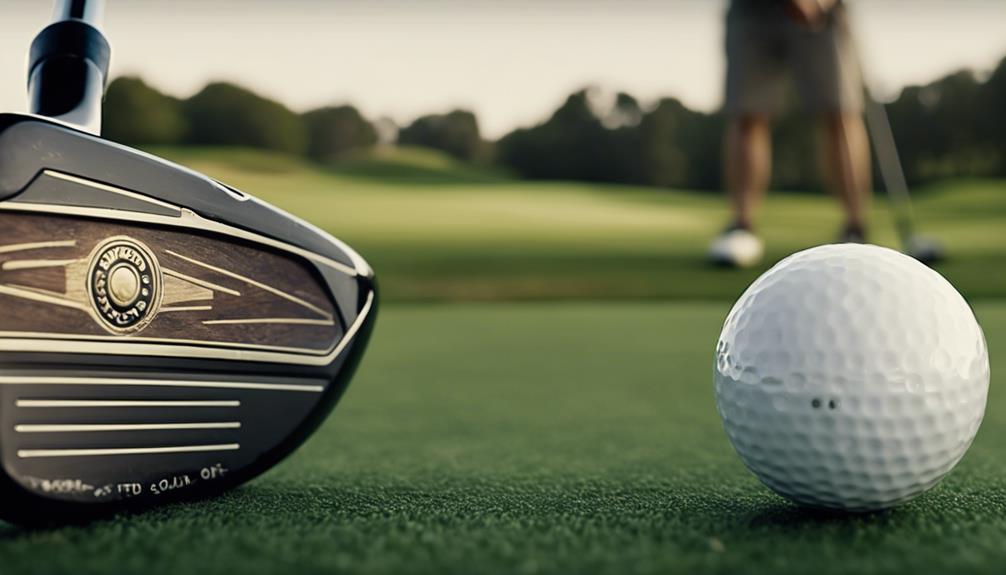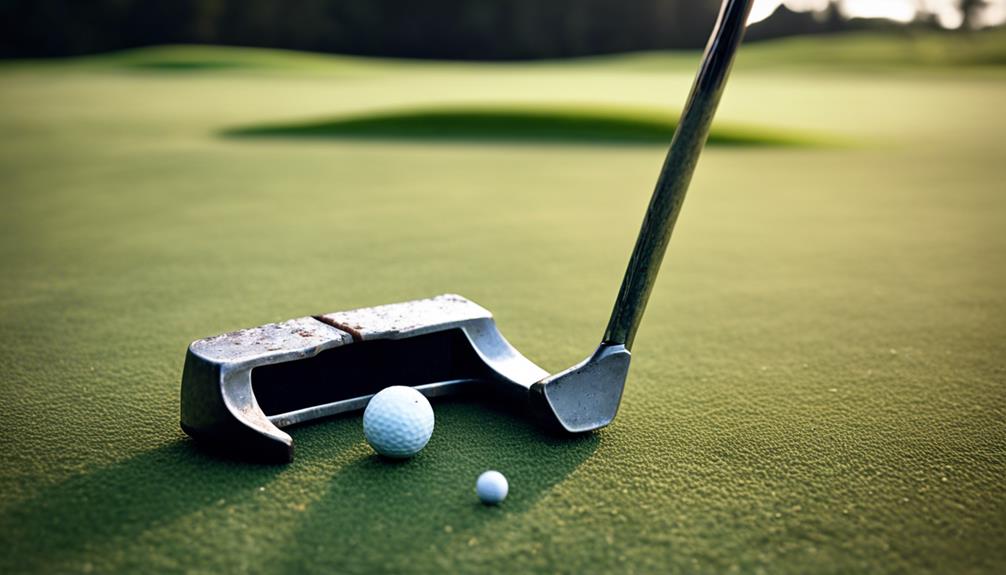- 7 Top Flite Golf Clubs XL for Improved Performance - September 28, 2024
- Top Flite Golf Clubs: Top 5 Reasons to Choose Them - September 28, 2024
- Top 3 Golf Club Fitters for a Perfect Swing - September 28, 2024
You can expect your golf clubs to last anywhere from a few years to over a decade, depending on factors such as usage patterns, quality, and maintenance. Drivers typically last around 3 years or 150 rounds, while irons average 300 rounds or 10 years. Proper care, including regular cleaning and maintenance, can extend the lifespan of your clubs. Factors like material durability, frequency of play, and technological advancements also come into play. Understanding the intricacies of golf club longevity will help you make informed decisions about when to replace your clubs and how to get the most out of them – and there's more to explore.
Key Takeaways
- Golf clubs can last anywhere from 3 to 10 years or more, depending on usage, quality, and maintenance.
- Drivers typically last around 3 years or 150 rounds, while fairway woods and hybrids last 3 to 5 years or 200 rounds.
- Irons can last around 300 rounds or 10 years, but well-maintained ones can last up to 400-500 rounds.
- Wedges should be replaced every 2 years for optimal performance, as groove wear and tear affects spin and control over time.
- Regular cleaning, maintenance, and storage can extend the lifespan of golf clubs and prevent wear and tear.
Factors Affecting Club Longevity
Your golf clubs' lifespan is greatly influenced by several key factors, including your usage patterns, the quality of the clubs themselves, and how well you maintain and care for them.
The frequency and intensity of your play will inevitably lead to wear and tear, which can reduce the lifespan of your clubs significantly. Additionally, the quality of materials and construction will also play a vital role in determining how long your clubs will last. Clubs made from high-quality materials will generally outlast those made from inferior materials.
Besides, your care and maintenance routines will also have a notable impact on the longevity of your clubs. Failing to clean and store your clubs properly can lead to premature wear and tear.
Lastly, technological advancements in club design can also render your clubs outdated and less effective over time. By understanding these key factors, you can take steps to extend the life of your golf clubs and get the most out of your investment.
Golf Club Replacement Frequency
How often do you find yourself replacing your golf clubs, and what drives this frequency? The answer may vary depending on your individual needs and preferences. However, grasping the general trend when it comes to golf club replacement frequency is crucial.
Here's a breakdown of how often golfers tend to replace their clubs:
- 7% replace their clubs every 12 months, likely due to the desire for the latest technology or to stay competitive.
- 17% change their clubs every 3 years, possibly due to noticeable wear and tear.
- 31% upgrade their clubs every 4 years, potentially motivated by the need for improved performance or changes in their swing.
- 43% hold on to their clubs for more than 4 years, likely due to satisfaction with their current equipment or budget constraints.
It's interesting to note that buying new equipment is a significant aspect of golf, and comprehending your replacement frequency can help you make informed decisions about when to upgrade. The shelf life of golf clubs varies, but being aware of your own habits can help you optimize your investment and enhance your game.
Tips to Extend Club Lifespan

To get the most out of your golf clubs, you'll want to focus on proper care and maintenance. By following essential club care habits, storing your clubs correctly, and performing regular maintenance checks, you can greatly extend their lifespan.
Club Care Essentials
By incorporating a few simple habits into your post-round routine, you can greatly extend the lifespan of your golf clubs. Cleaning clubs after each shot with a wet and dry towel can prevent dirt buildup and extend their lifespan. This habit, combined with the right tools, can make a significant difference.
Here are the club care essentials you should prioritize:
- Clean clubs regularly: Use a wet and dry towel to remove dirt and debris after each shot.
- Brush it off: Utilize a metallic brush for iron grooves and a plastic brush for metal clubs to maintain their performance.
- Grip it and rip it: Change club grips annually to improve grip traction and overall feel during play.
- Cover up: Use head covers when clubs aren't in use to shield them from potential damage and wear.
Proper Storage Methods
You're taking the right steps to extend the life of your golf clubs by prioritizing club care essentials, and now it's time to focus on proper storage methods that can further prevent damage and deterioration.
When storing your clubs, make certain to keep them in a cool, dry place away from extreme temperatures and humidity. This will help prevent damage and deterioration.
Additionally, using head covers on your clubs when not in use is a great way to protect them from scratches and dents, which can prolong their lifespan.
Avoid exposing your clubs to harsh chemicals or abrasive materials during storage, as this can compromise the integrity of the club materials.
Before storing your clubs, take the time to properly clean them to prevent dirt and debris buildup, which can accelerate wear and tear over time.
Finally, regularly inspect your clubs for any signs of damage and address any maintenance needs promptly.
Regular Maintenance Tips
Regular upkeep is crucial to extending the lifespan of your golf clubs, and integrating simple habits into your routine can make a significant difference in their overall performance and durability. By following these maintenance tips, you can prolong the life of your clubs and guarantee they continue to perform at their peak.
Here are some essential maintenance tips to extend the life of your golf clubs:
- Clean your clubs after each shot or round to prevent dirt buildup and corrosion.
- Utilize head covers when your clubs aren't in use to shield them from damage and wear.
- Renew your club grips annually to uphold a good feel and performance.
- Consistently examine your clubs for damage and conduct maintenance promptly to prevent issues from escalating.
Club Fitting and Maintenance
As you continue to refine your game, periodic club fittings become vital to ensure your golf clubs remain properly suited to your evolving swing dynamics and playing style. Regular club fittings guarantee you're using the most appropriate equipment, as club technology evolves over time. Additionally, improvements in your swing speed or playing ability may require changes in club fitting to optimize performance.
Proper club fitting and maintenance go hand-in-hand. You should maintain your clubs regularly to address wear and tear issues promptly, extending their lifespan. Neglecting maintenance can lead to damage, reducing your clubs' performance and ultimately affecting your game.
By combining regular club fittings with proper maintenance, you'll be able to enjoy peak performance from your clubs for a longer period. This is important, as even slight changes in your playing style, skill level, or physical attributes can impact your club fitting needs.
Driver, Wood, and Hybrid Durability

By analyzing the durability of specific club types, it becomes clear that drivers, fairway woods, and hybrids have distinct lifespans that require attention to guarantee peak performance. As a golfer, you want to make sure you're getting the most out of your clubs, and understanding their lifespan is essential.
Here are some key takeaways to keep in mind:
- Drivers: typically last around 3 years or 150 rounds of play before experiencing a drop in performance.
- Fairway woods: have a lifespan of 3 to 5 years or approximately 200 rounds of golf.
- Hybrids: also last around 3 to 5 years or approximately 200 rounds of golf.
- Performance impact: failing to replace these clubs within their recommended lifespan can result in decreased distance, accuracy, and overall performance.
Iron and Wedge Longevity Factors
As you evaluate the lifespan of your irons and wedges, you'll need to contemplate three key factors that influence their durability.
The material used in their construction matters, as does the frequency with which you play and the resulting wear on the clubs.
Additionally, the rate at which the grooves wear down will impact their overall performance and lifespan.
Material Durability Matters
High-grade materials and construction have a significant impact on the lifespan of irons, which is why they typically outlast other clubs in your bag. You can expect your irons to last around 300 rounds or 10 years of play, thanks to their sturdy design.
On the other hand, wedges take a beating and should be replaced every 2 years to maintain clean and sharp clubfaces.
Here are some key factors to take into account when it comes to material durability:
- Top-notch metals: High-quality irons are made from resilient metals that resist corrosion and wear.
- Strong coatings: Wedges with tough coatings can withstand the rigors of sand and rough.
- Precise tolerances: Well-constructed clubs with precise tolerances reduce the risk of damage and wear.
- Cutting-edge manufacturing: Modern manufacturing techniques guarantee that clubs are built to last.
Frequency of Play Impact
You'll find that the frequency of play has a significant impact on the lifespan of your irons and wedges, with regular use leading to noticeable wear and tear over time. As you play more frequently, your irons and wedges are subjected to increased stress, causing them to degrade faster.
| Club Type | Average Lifespan |
|---|---|
| Irons | 300 rounds |
| Wedges | 60-100 rounds |
| Wedges (in challenging conditions) | 30-60 rounds |
| Well-maintained irons | 400-500 rounds |
| Properly cared for wedges | 100-150 rounds |
The quality of your play and the type of shots you make with your irons and wedges also affect their longevity. For instance, if you frequently hit shots from sand traps or rough areas, your wedges may need to be replaced more often. On the other hand, proper care and maintenance can extend the lifespan of your irons and wedges, ensuring they perform well over time. By understanding the impact of frequency of play on your irons and wedges, you can take steps to maximize their lifespan and maintain your game.
Groove Wear and Tear
The continuous striking of clubface against ball and turf gradually wears down the grooves on your irons and wedges, affecting spin and control with each subsequent shot. While playing, the grooves on your irons and wedges deteriorate, impacting the quality of your shots. This groove erosion plays a crucial role in determining the lifespan of your irons and wedges.
Here are some key points to remember:
- Regular cleaning and maintenance can prolong the longevity of your irons and wedges.
- Wedges, used in tough conditions, tend to deteriorate faster than other clubs.
- Irons and wedges can endure approximately 300 rounds, equivalent to 5 years of regular play.
- Replacing wedges every 2 years can help sustain peak playability.
To get the most out of your irons and wedges, prioritizing club maintenance is crucial. By consistently cleaning and maintaining your grooves, you can extend their lifespan and ensure they continue to perform at their peak.
Putter Performance and Replacement

On average, a well-maintained putter can last for more than a decade, with minimal wear and tear compared to other clubs in your bag. This extended lifespan allows you to focus on refining your putting technique without worrying about the club itself.
Before contemplating an upgrade, it's recommended that you hold onto a new putter for at least one full season to get accustomed to its feel and performance. With today's putters offering advanced technology for forgiveness and consistency in putting, you may find that your current putter still has a lot to offer.
However, if your putter is over 10-15 years old and you're noticing a decline in performance, it might be time to upgrade to a newer model. Upgrading putters can breathe new life into your game, and with the rapid advancements in technology, you may find that a new putter notably improves your putting performance.
Ultimately, the decision to upgrade is yours, but by keeping your putter in good condition and staying aware of its performance, you'll be well on your way to mastering the green.
Signs of Worn-Out Golf Clubs
As you continue refining your putting technique, it's equally crucial to monitor the overall condition of your golf clubs, as worn-out clubs can have a significant impact on your game's overall performance.
You may not notice the subtle changes, but worn-out golf clubs can affect your accuracy, distance, and overall score.
Here are some signs to look out for:
- Visible damage: Cracks, dents, or scratches on the clubheads can notably alter the club's performance.
- Loss of feel: If you're no longer getting the same feedback during your swings, it may be time to replace your golf clubs.
- Worn grips: Smooth or shiny areas, fraying, or loss of texture can all indicate worn-out grips.
- Decreased performance: If you're noticing a decline in your distance or accuracy compared to previous performances, it may be due to worn-out golf clubs.
Frequently Asked Questions
How Do You Know if Golf Clubs Are Worn Out?
You'll know your golf clubs are worn out if you notice signs of deterioration, such as worn-out grips, and if you experience a decline in performance, like reduced distance, after proper maintenance, cleaning, and storage.
How Do I Know When to Get New Golf Clubs?
You'll know it's time for new golf clubs when you notice performance declines, despite regular maintenance; consider club fitting, technology advancements, and budget constraints, while weighing resale value, customization options, and personal preferences that align with your evolving game.
How Long Do Golf Irons Last?
As you wield your trusty iron like a precision scalpel, you wonder how long it'll remain sharp; iron durability is key, but longevity factors like maintenance and usage influence replacement timing, typically around 5 years or 300 rounds.
How Many Rounds Does a Driver Last?
You can expect your driver to last around 150 rounds, depending on club head durability, shaft flexibility, and grip wear, which affect performance, but regular maintenance and inspections can help extend its lifespan.
Conclusion
As you stand on the green, gazing out at the lush landscape, you hold in your hands a tool that's both a trusted companion and a fleeting moment in time. Golf clubs, like the game itself, are a delicate balance of strength and fragility.
While they can withstand the force of a 100mph swing, they're also susceptible to the subtle erosions of time and use. By understanding the factors that affect their longevity, you can extend their lifespan and keep your game sharp.




